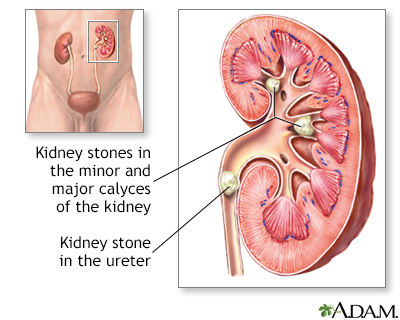- Status
- Accepting Candidates
Urine - bloody
Definition
Blood in your urine is called hematuria. The amount may be very small and only detected with urine tests or under a microscope. In other cases, the blood is visible. It often turns the toilet water red or pink. Or, you may see spots of blood in the water after urinating.
Alternative Names
Hematuria; Blood in the urine
Causes
There are many possible causes of blood in the urine.
Bloody urine may be due to a problem in your kidneys or other parts of the urinary tract, such as:
- Cancer of the bladder or kidney
- Infection of the bladder, kidney, prostate, or urethra
- Inflammation of the bladder, urethra, prostate, or kidney (glomerulonephritis)
- Injury to the bladder or kidney
- Kidney or bladder stones
- Kidney disease after strep throat (post-streptococcal glomerulonephritis), a common cause of blood in the urine in children
- Kidney failure
- Polycystic kidney disease
- Recent urinary tract procedure such as catheterization, circumcision, surgery, or kidney biopsy
Patient Education Video: Kidney stones
If there is no structural or anatomical problem with your kidneys, urinary tract, prostate, or genitals, your doctor may check to see if you have a bleeding disorder. Causes may include:
- Bleeding disorders (such as hemophilia)
- Blood clot in the kidneys
- Blood thinning medicines (such as aspirin or warfarin)
- Sickle cell disease
- Thrombocytopenia (low numbers of platelets)
Blood that looks like it is in the urine may actually be coming from other sources, such as:
- The vagina (in women)
- Ejaculation, often due to a prostate problem (in men)
- A bowel movement
The urine can also turn a red color from certain drugs, beets, or other foods.
Home Care
When to Contact a Medical Professional
You may not see blood in your urine because it is a small amount and is microscopic. Your health care provider may find it while checking your urine during a routine exam.
Never ignore blood you see in the urine. Get checked by your provider, especially if you also have:
- Discomfort with urination
- Frequent urination
- Unexplained weight loss
- Urgent urination
Contact your provider right away if:
- You have fever, nausea, vomiting, shaking chills, or pain in your abdomen, side, or back
- You are unable to urinate
- You are passing blood clots in your urine
Also contact your provider if:
- You have pain with sexual intercourse or heavy menstrual bleeding. This may be due to a problem related to your reproductive system.
- You have urine dribbling, nighttime urination, or difficulty starting your urine flow. This may be from a prostate problem.
What to Expect at Your Office Visit
Your provider will perform a physical exam and ask questions such as:
- When did you first notice blood in your urine? Has the amount of your urine increased or decreased?
- What is the color of your urine? Does your urine have an odor?
- Do you have any pain with urination or other symptoms of infection?
- Are you urinating more often, or is the need to urinate more urgent?
- What medicines are you taking?
- Have you had urinary or kidney problems in the past, or recently had surgery or an injury?
- Have you recently eaten foods that may cause a change in color, like beets, berries, or rhubarb?
Tests that may be done include:
- Abdominal ultrasound
- Antinuclear antibody test for lupus
- Blood creatinine level
- Complete blood count (CBC)
- CT scan of the abdomen
- Cystoscopy
- Kidney biopsy
- Strep test
- Tests for sickle cell, bleeding problems, and other blood disorders
- Urinalysis
- Urinary cytology
- Urine culture
- 24-hour urine collection for creatinine, protein, calcium
- Blood tests such as PT, PTT or INR tests
The treatment will depend on the cause of blood in the urine.
Gallery



References
Boorjian SA, Raman JD, Barocas DA. Evaluation and management of hematuria. In: Partin AW, Domochowski RR, Kavoussi LR, Peters CA, eds. Campbell-Walsh-Wein Urology. 12th ed. Philadelphia, PA: Elsevier; 2021:chap 16.
Brown DD, Reidy KJ. Approach to the child with hematuria. Pediatr Clin North Am. 2019;66(1):15-30. PMID: 30454740 pubmed.ncbi.nlm.nih.gov/30454740/.
Elsamra SE. Evaluation of the urologic patient: history and physical examination. In: Partin AW, Domochowski RR, Kavoussi LR, Peters CA, eds. Campbell-Walsh-Wein Urology. 12th ed. Philadelphia, PA: Elsevier; 2021:chap 1.
Landry DW, Bazari H. Approach to the patient with renal disease. In: Goldman L, Schafer AI, eds. Goldman-Cecil Medicine. 26th ed. Philadelphia, PA: Elsevier; 2020:chap 106.
Related specialties
Our experts
Clinical Trials: Urine - bloody
UF Health research scientists make medicine better every day. They discover new ways to help people by running clinical trials. When you join a clinical trial, you can get advanced medical care. Sometimes years before it's available everywhere. You can also help make medicine better for everyone else. If you'd like to learn more about clinical trials, visit our clinical trials page. Or click one of the links below:
